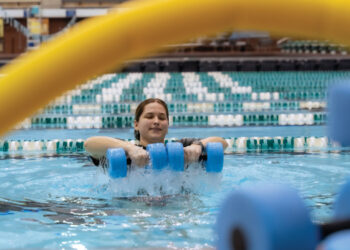In the May/June 2022 issue, James Rimmer, the director of the National Center on Health, Physical Activity and Disability (NCHPAD), shares advice on accessibility and inclusion.
What are some of the biggest challenges when it comes to accessibility and inclusion in club sports and intramurals?
JR: I think the first challenge is really getting these young individuals coming out of high school into higher education and into college. Right now, we really have a very small number of youth with disabilities who transition into college.
Everything you see in the disability community is, “Nothing about us without us.”
That’s the place where you could begin to recruit students with disabilities into focus groups and other meetings. They can tell you what they need in order to participate in competitive recreation and sports.
What are some ways campus rec can be more inclusive in this area?
JR: There’s an instrument we developed many years ago called AIMFREE. It stands for Accessibility Instruments Measuring Fitness in Recreation Environments. I would encourage you to look at and to do an assessment to determine where there may be potential gaps.
In the AIMFREE instrument, there are different domains of inclusion. One is just a simple fact of, what does the exterior of that facility look like? Are there enough parking spaces in front of the building? Are there clean and accessible curb cuts? Sometimes there are sidewalks, and sometimes there aren’t. So, it’s challenging for many people to find a curb cut on occasion, because the curb cut may be at a distance from where the accessible pocket is.
Once you get through the exterior to make sure that’s all safe, then your entrances are also part of the evaluation process in AIMFREE. Today, everything is automatic doors. You don’t want to touch handles. Sometimes handles are very difficult for people to open.
All of the programs need somebody to do a deep analysis. The tai chi and the yoga and the swimming and the basketball programs — are they all accessible? You need to do an audit or a survey of the facility to make sure it’s accessible to everyone.
Can you share a bit on what NCHPAD is doing to further accessibility and inclusion?
JR: We don’t necessarily focus at the college level, but we do have a number of communities that are developing what we refer to as Inclusive Health Coalitions. These are communities where you’re trying to get a group of people to participate in the coalition. Then begin to think about the problems associated with that community that need to be addressed.
This does a number of things. Obviously, it increases your visibility and your value to a community. Getting the community involved in what you’re doing is probably another good first step, once you identify how to recruit students with disabilities to the campus. Maybe there are already people in town who have disabilities who want to enroll in college as a result of participating in a competitive or campus recreation program.
That’s what we’re doing in NCHPAD. We’re really trying to get these inclusive communities across the country to understand we’re not asking them to do a certain thing. But we’re asking them to develop an inclusive long-range plan. Come out with a call to action on what that community would like to do.










